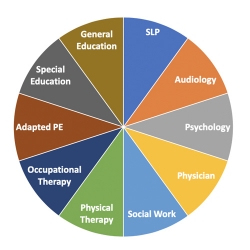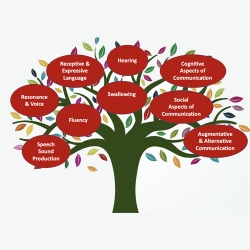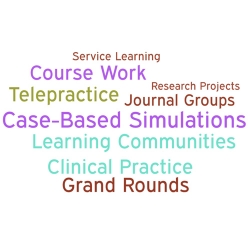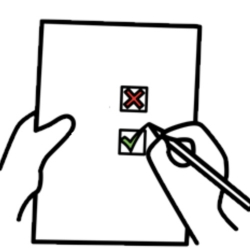Implementing IPE
In order to implement IPE in professional preparation programs, a number of components need to be considered that include answers to the following questions:
Resources for the components listed above are provided in each of the sections below, with links to tools that may be downloaded for developing IPE events.

Disciplines Involved in IPE
The image above illustrates the potential array of disciplines in IPE, particularly in the field of speech, language and hearing sciences. A key principle in IPE is that collaboration of all relevant professions creates optimal outcomes for the people we serve. For more on the breadth of disciplines in IPE, see the World Health Organization's Framework for Action on Interprofessional Education & Collaborative Practice.

Scope of Issues in IPE
The focus of collaboration in IPE is determined by the disciplines involved. In Speech-Language Pathology, for example, the focus of IPE can be determined by the required areas of study, known as the "Big Nine." IPE case studies are developed around each of these areas. See ASHA 2020 SLP Certification Standard IV-C for more information on the required "Big Nine" areas of study.

Multiple Formats for IPE
IPE can be implemented in multiple formats, as illustrated above. Since 2019, SLHS has hosted stand-alone IPE events and launched a required graduate seminar, SLHS 714: Interprofessional Education and Family Centered Practice. ASHA's document on the Value of Collaborating provides multiple examples of IPE formats In addition, an introductory PPT on IPE is provided below.

Steps to Coordinate IPE events
Any type of IPE event requires planning. For example, in SF State's first IPE event, the planning committee (PC) included two faculty advisors and six undergraduate members of the National Student Speech-Language and Hearing Association (NSSLHA). Planning steps over two months included: (1) advertising, (2) resource materials, (3) logistics, (4) designing case studies, (5) facilitation and (6) evaluation. Tools provided below include the IPE Planning Checklist and IPE Evaluation.
For PDF files, you'll need Adobe Acrobat 5.0 or above to view it. If you need Adobe Acrobat Reader it's available free from Adobe.